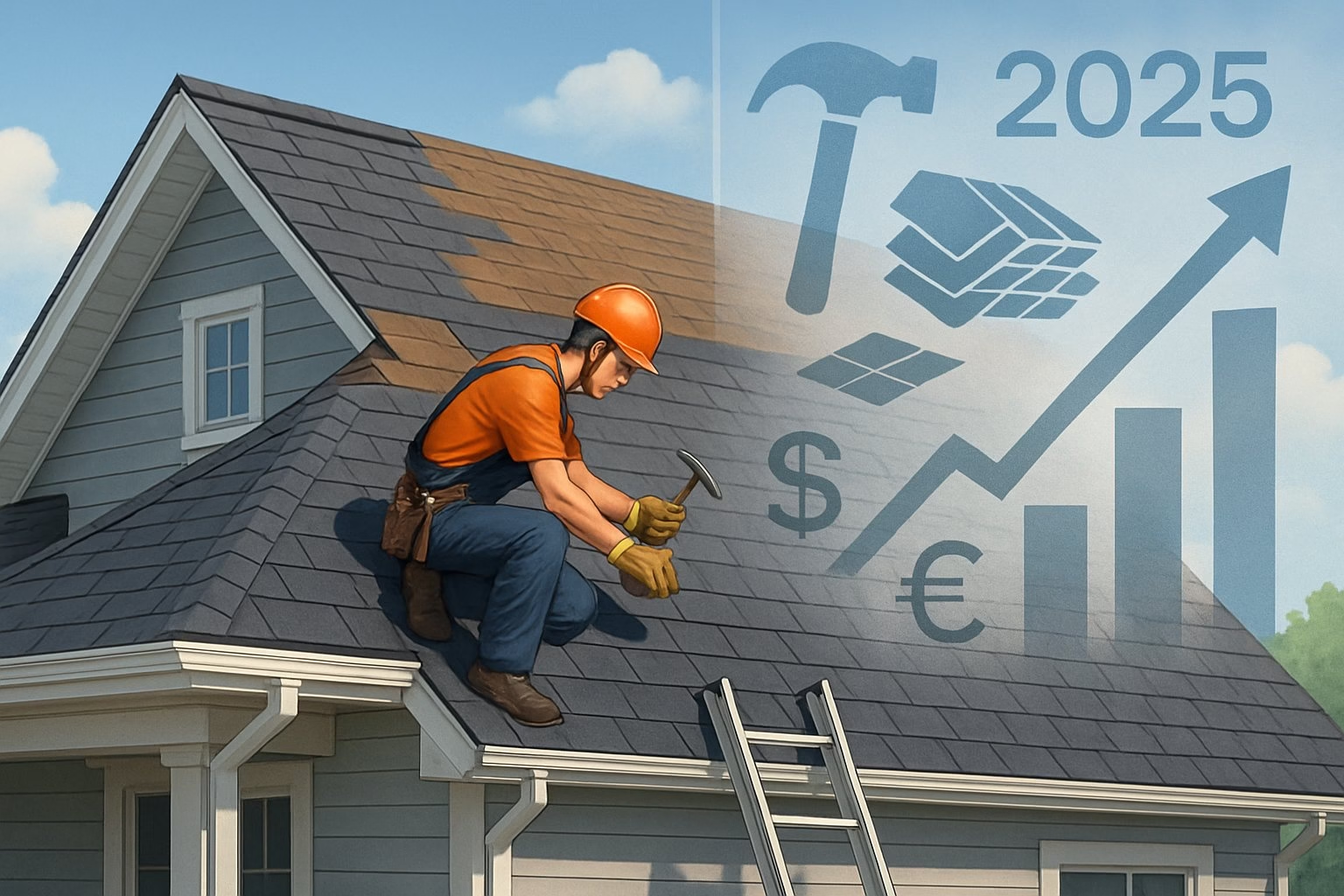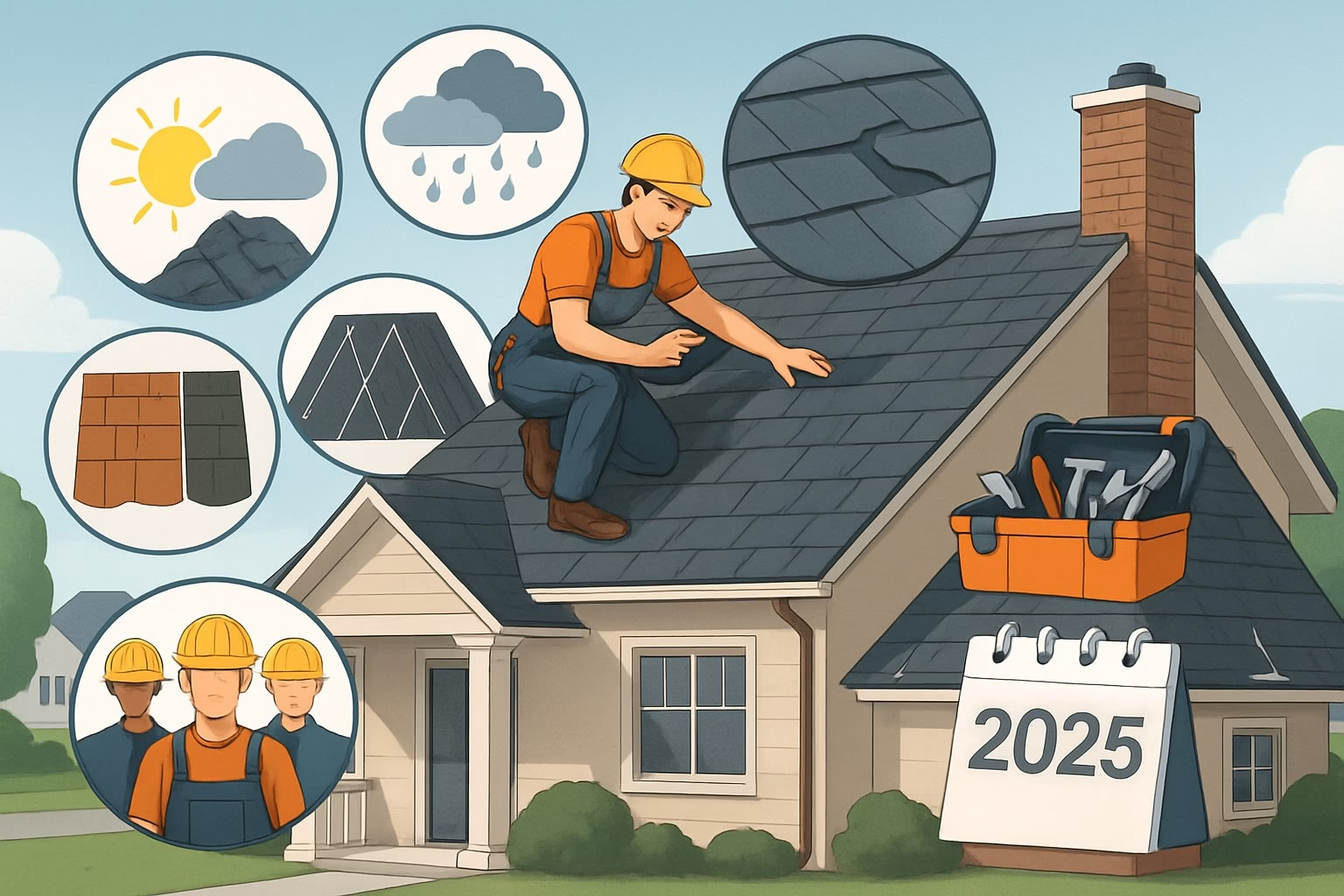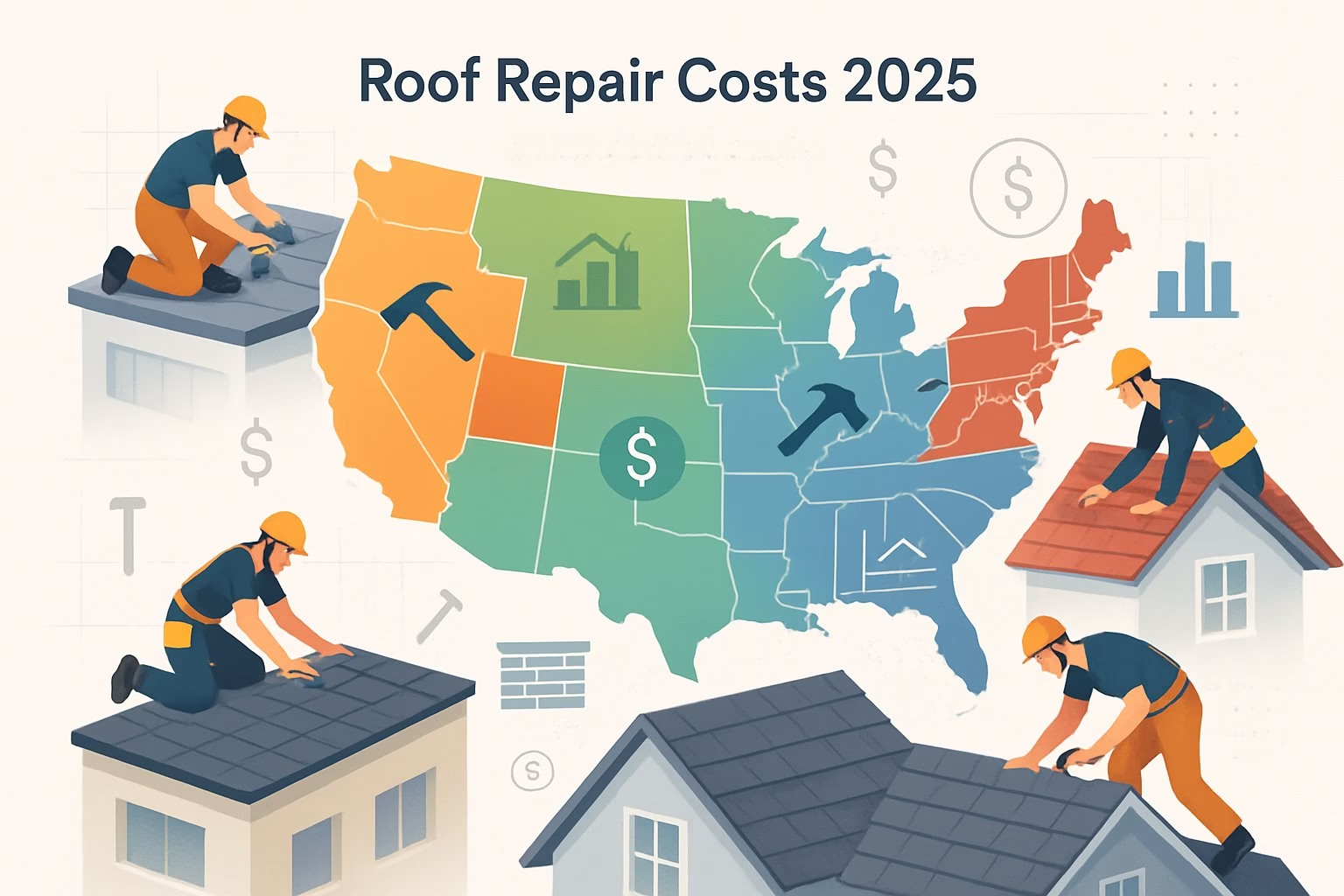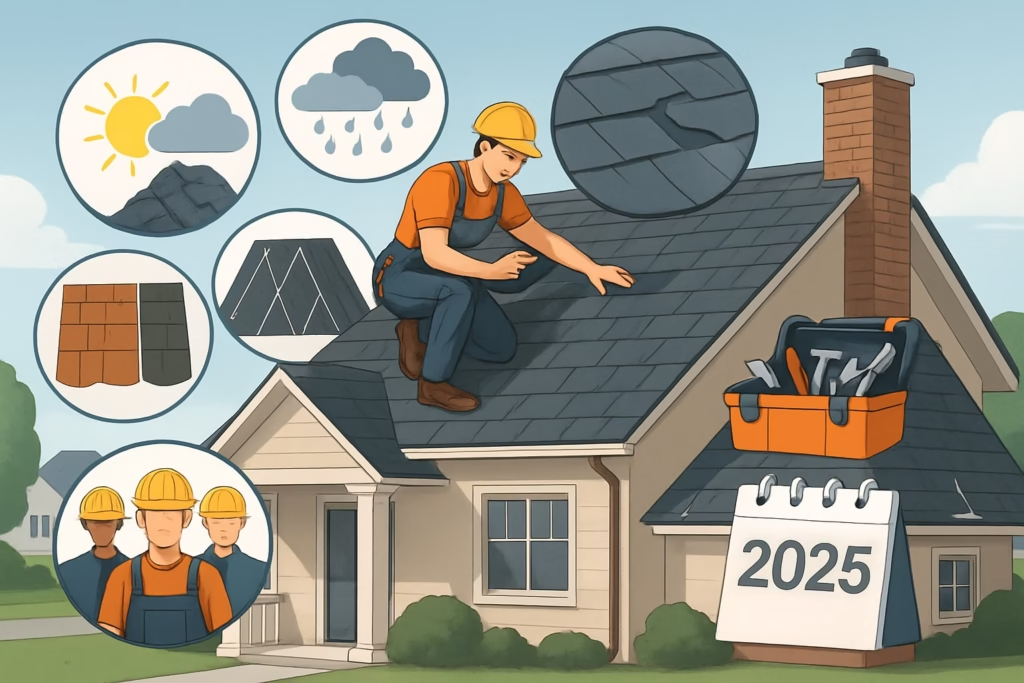Getting a roof fixed can feel like a punch to the wallet, especially when prices seem to climb every year. The average roof repair in 2025 sits at $1,150, but most folks end up paying anywhere from $350 to $1,900, depending on what’s actually wrong.
Small jobs, like swapping out a few shingles, might only set you back $150 to $450. On the other hand, if you’re dealing with major leaks or structural issues, costs can shoot up to $6,500 or even more.

So, why are prices higher this year? Material costs jumped—everything from asphalt to metal shingles costs more in 2025. Labor isn’t cheap either; wages have gone up, making even basic repairs pricier than you might expect.
The type of damage really sets the tone for the bill. Fixing wind damage or a few missing shingles usually costs less than dealing with hail or a tree crashing through your roof.
Where you live matters too. Coastal and northeastern states almost always pay more than places in the Midwest or South. It’s worth knowing what drives these costs if you want to avoid being blindsided.
Key Takeaways
- Most roof repairs in 2025 fall between $350 and $1,900, averaging $1,150
- Material and labor hikes have pushed repairs about 20% higher than a couple years ago
- Damage type and roof material make the biggest difference in price
Average Roof Repair and Replacement Costs in 2025
Nationally, roof repairs average about $1,150. Replacing a whole roof? That’s a different beast—expect $20,000 to $30,000 for most homes.
Material prices kept climbing through 2024 and into 2025, so yeah, roofing costs are up again.
Typical Price Ranges for Repairs
Most people spend between $400 and $1,900 for repairs this year. The final amount depends on what’s damaged and what kind of roof you have.
Minor repairs—think small leaks or a handful of missing shingles—run $150 to $800.
Moderate repairs (bigger shingle jobs, patching metal, fixing more than one spot) usually cost from $400 to $1,200.
Major repairs can go from $800 up to $1,900 or more. That’s when you’re dealing with structure, big leaks, or replacing big chunks of roof.
Asphalt shingle repairs stay on the cheaper side. Metal, slate, or tile? Those cost more to fix, no surprise there.
Typical Price Ranges for Replacements
Replacement costs are all over the map, depending on your roof’s size, the materials, and where you live. The national average for a standard home is $30,680.
For asphalt shingles, most folks pay between $20,000 and $25,000. That covers about 30 squares of architectural shingles on an average-sized house.
Cost per square foot by material:
- 3-tab shingles: $4.00
- Architectural shingles: $6.40
- Luxury shingles: $8.50
- Steel standing seam: $16.00
- Cedar shake: $25.00
- Slate tiles: $25.00-$30.00
If you want the good stuff—like copper—expect $30 to $50 per square foot. Where you live can swing these numbers a lot.
How Costs Have Changed in Recent Years
Roofing prices keep inching up, mostly because materials cost more. This trend hasn’t slowed down in 2025 and probably won’t next year either.
Material costs jumped the most. Supply chain headaches and inflation pushed prices up across the board.
Labor went up too, since roofers are in short supply. Contractors are paying more to keep good workers, so you pay more too.
The difference between budget and fancy materials is bigger now. Metal and specialty roofs saw the biggest jumps, while standard asphalt only crept up a bit.
Some regions are just plain expensive. In certain areas, you’ll pay 20-30% more than the national average.
Key Factors Affecting Roof Repair Pricing

Lots of things mess with roof repair pricing in 2025. Roof size, how steep it is, what’s actually broken, and even when you call for repairs—all of it matters.
Roof Size and Pitch
Bigger roofs cost more, plain and simple. Contractors measure in “squares”—each one covers 100 square feet.
If you’re fixing just one square, it’s way cheaper than patching up several. More roof means more time and materials.
Pitch changes everything. Low-pitched roofs (under 4/12) are easy and cheap to fix. Most homes fall in the 4/12 to 8/12 range, which is pretty standard.
Steep roofs (over 8/12) can cost 25-50% more. Workers have to move slower and use extra safety gear. Some contractors tack on fees if they think a roof’s too risky.
Really steep roofs might need scaffolding or lifts. That alone can add hundreds to your bill.
Roof Complexity and Accessibility
Roofs with lots of levels, dormers, or weird angles cost more. Every extra feature is more work and more places for leaks.
Chimneys, skylights, and vents make repairs trickier. Workers have to seal around them carefully, which takes more time and materials.
Getting to the roof can be half the battle. Two-story homes cost more to fix than single-story ones. If houses are close together, it’s tough to set up ladders and tools.
Trees, power lines, or even landscaping can get in the way. Sometimes contractors need special gear or extra hours just to get started.
If a crane’s involved for material delivery, expect to pay $500-$1,500 more, depending on how long they need it.
Extent and Type of Roof Damage
Minor stuff—like a few missing shingles—usually costs $150-$450. If the damage hits the structure, you’re looking at $2,000-$6,500 or higher.
Damage types and what they cost:
- Hail damage: $600-$6,500, depending on how much got hit
- Roof leaks: $200-$2,500, based on where it started and how far it spread
- Wind damage: $250-$1,500 for missing shingles and caps
- Tree damage: $900-$6,500+ (and that includes getting rid of the tree debris)
Storms usually mess up more than one spot, so repairs add up. If water gets to the roof deck, you’ll need structural fixes, which always cost more since workers have to replace wood before putting on new shingles.
Timing and Urgency of Repairs
If you need a repair right now, get ready to pay extra. Emergency, after-hours, and weekend calls can double your costs.
Storm season is nuts—contractors are slammed, and prices can jump 20-40% just because everyone needs help at once.
Winter repairs hurt the wallet in cold places. Snow removal and weather delays slow everything down. Some materials just don’t work right when it’s freezing.
Stopping an active leak in a hurry means premium rates. Emergency calls and temporary fixes like tarps aren’t cheap.
If you plan ahead and schedule repairs in the slow season (think fall or early spring), you’ll probably get better prices and more contractor options.
Roofing Materials and Their Impact on Costs
The roofing material you pick can make a huge difference in repair costs. Basic asphalt shingles are way cheaper than slate or tile. Your choice affects not just the upfront price, but also what you’ll pay to keep it up over the years.
Asphalt Shingles: Budget-Friendly Choice
Asphalt shingles are still the go-to for cheap repairs in 2025. Swapping out missing shingles usually costs $300 to $400.
Here’s the typical breakdown:
- Minor fixes: $150 to $450
- Replacing missing shingles: $300 to $400
- Moderate leak repairs: $500 to $1,000
Materials don’t cost much, and labor stays low since roofers have done these jobs a million times.
Architectural shingles cost more than basic 3-tabs, but they last longer and handle wind better. Asphalt’s everywhere, so prices don’t swing much between regions.
Metal Roofs: Durability Versus Price
Metal roofs cost more to repair upfront, but you’ll probably need fewer fixes over the years. Most repairs focus on fasteners, flashing, or sealant, not swapping out big panels.
Common prices for metal repairs:
- Fastener replacement: $200 to $500
- Flashing repairs: $400 to $800
- Panel replacement: $600 to $1,200
Metal stands up to wind better than most materials, so you might dodge some emergency calls after storms.
Standing seam roofs are pricier to fix than corrugated ones. You need a contractor who knows metal, and they usually charge 20-30% more than for asphalt jobs.
Tile and Slate Roofing: Premium and Luxury Options
Tile and slate repairs are expensive—no way around it. Just replacing a single tile can cost $100 to $300.
Premium repair ranges:
- Clay tile: $400 to $1,000
- Concrete tile: $300 to $800
- Slate: $800 to $2,000
These roofs need extra structural support, which adds to the price. Finding a match for older tiles or slate can be a headache and sometimes means custom orders.
Specialized roofers charge more for this work. The weight and fragility of these materials mean you need skilled pros and extra safety gear.
Regional Variations and Labor Rates

Roof repair prices swing wildly depending on where you live. Some states pay up to 70% more for the same job than others.
Labor rates run from $30-48 per hour in cheaper areas, but can hit $80-115 per hour in pricey markets. It’s definitely worth shopping around and asking for local quotes if you want the best deal.
How Labor Costs Differ Across States
Labor rates for roofing contractors create the biggest price differences between states. The national average hourly rate sits somewhere between $40 and $70, but the real numbers swing a lot depending on where you live.
Highest Labor Rate States:
- Hawaii: $80-115/hour
- California: $75-110/hour
- New York: $70-100/hour
- Alaska: $70-100/hour
Lowest Labor Rate States:
- Puerto Rico: $30-48/hour
- Mississippi: $33-50/hour
- West Virginia: $35-53/hour
- Arkansas: $35-55/hour
States like California and Hawaii charge premium rates, mostly because it costs more to live and work there. Strict licensing rules also bump up prices.
Southern and rural states keep overhead costs down, so labor is cheaper. Weather plays a role too—places with rough winters or wild weather, like Alaska, need special installation skills that drive up costs.
Urban Versus Rural Price Differences
Major cities usually charge more than rural spots, even within the same state. Urban markets can be 20-40% pricier, which is a pretty big jump.
City Premium Examples:
- California: Los Angeles ($19,400) vs rural areas ($16,000-17,000)
- New York: NYC ($21,000) vs Buffalo ($12,700)
- Texas: Austin ($11,900) vs rural areas ($9,500-10,500)
Urban contractors deal with higher business expenses like permits, insurance, and storing their gear. City rules often mean more inspections and paperwork, which adds up.
Rural areas get by with lower overhead and less competition. But getting materials delivered can cost more if you’re out in the sticks. Sometimes, there just aren’t enough experienced roofers, so prices spike during busy times.
How Roof Inspections and Maintenance Influence Spending
Regular roof inspections cost between $250 and $350. They can keep you from paying thousands in repairs down the road.
Spotting issues early with professional maintenance helps you catch small stuff before it turns into leaks or serious damage.
Role of Roof Inspections in Early Detection
Inspectors see things you just can’t spot from the ground. They look for damaged shingles, worn-out flashing, and blocked drainage.
Early detection saves money by catching:
- Small roof leaks before water damages interior structures
- Loose or missing shingles before wind causes more damage
- Clogged gutters before they cause foundation problems
- Worn sealants around vents and chimneys
Sometimes, a $300 inspection uncovers a $500 repair that could’ve turned into a $5,000 headache. Water damage moves fast—decking, insulation, drywall, you name it.
Most roofers recommend yearly inspections for roofs over 10 years old. If you get hit with a big storm, it’s smart to check things out right after.
Insurance companies often want official inspections before they’ll pay out. Some even give discounts if you keep up with regular checks.
Preventative Maintenance to Reduce Long-Term Costs
Simple maintenance can stretch your roof’s life by 5-10 years. You’ll pay $300-$800 a year, but it beats replacing the whole thing early.
Key maintenance tasks include:
- Cleaning gutters and downspouts ($150-$300)
- Replacing damaged shingles ($200-$500 per section)
- Sealing around vents and chimneys ($100-$250)
- Trimming overhanging tree branches ($200-$400)
Fixing small stuff, like a $200 shingle repair, stops leaks that could cost you $2,000 or more inside the house.
Skip maintenance and you’ll probably replace your roof 5-7 years sooner than you’d like. That’s $10,000-$20,000 you could avoid spending.
Keeping up with maintenance also keeps your warranty valid. Most manufacturers want proof you’re taking care of things.
Money-Saving Strategies and Considerations
If you plan it right, you can cut roof repair costs by 20-50%. It’s all about doing your homework on contractors, picking smart materials, and knowing your financing options.
Comparing Roofing Contractors and Getting Multiple Bids
Get at least 2-3 quotes. You’ll spot overpriced contractors and see what’s actually fair for your area.
Look beyond the bottom line. Material quality, warranty, and what’s included matter just as much as the price. Sometimes the cheapest bid means corners get cut.
Red flags to avoid when choosing contractors:
- Deposit requirements over 50% of total cost
- No permit fees included in contract
- Asking homeowner to pull permits themselves
- Fewer than 100 Google reviews or ratings below 4.8
Licensed, insured contractors might cost more up front, but they’re usually worth it. Local companies with good reputations tend to stick around for future repairs or warranty work.
Always check licenses, insurance, and local experience. Read every contract closely—especially for permit details—to avoid ugly surprises later.
Evaluating Energy-Efficient Roofing for Long-Term Savings
Energy-efficient materials can shrink your utility bills and qualify for tax credits or rebates. They cost more at first, but pay off over time.
Metal roofs and cool-roof shingles reflect heat better, so you’ll spend less on air conditioning. Some insurance companies even lower rates for these roofs in stormy areas.
Available incentives for energy-efficient roofing:
- Federal tax credits up to 30% of qualified expenses
- State-specific programs like Florida’s PACE financing
- USDA rural repair grants
- Local utility rebates for cool-roof materials
If you’re settling in for the long haul, premium energy-efficient roofs make sense. Selling soon? Stick to cost-effective options with basic efficiency.
The DSIRE database is handy for finding local incentives. Some places offer special loans just for energy upgrades.
Planning for Financing, Insurance, and Unexpected Expenses
Financing helps you spread out costs instead of paying all at once. Many contractors offer 0% deals for 12 months or longer payment plans.
Home equity lines of credit (HELOCs) usually have lower rates than personal loans, but take longer to set up and use your house as collateral. Some folks dip into 401(k) loans, since the interest goes back into their own retirement.
Insurance coverage situations:
- Storm damage, hail, and falling trees usually covered
- Gradual wear and maintenance issues not covered
- Vandalism and fire damage typically included
- Age-related deterioration excluded from most policies
If your roof gets damaged, document everything right away and call your insurance company. Waiting too long can tank your claim. Inspections help spot covered damage you might overlook.
Most financial advisors suggest saving 1% of your home’s value each year for big repairs. On a $300,000 house, that’s about $3,000 a year for roof upkeep or eventual replacement.
Frequently Asked Questions
People always want to know what materials cost—expect $100 to $1,500 per square, depending on the type. Labor makes up 30-50% of your bill, and the size of your house is a big factor, with total costs ranging from $5,000 up to $25,000.
What are the current average roofing material costs per square foot in 2025?
Asphalt shingles run $100-$150 per square and are still the budget pick. They last 15-30 years and do the job for most folks.
Metal roofing costs $300-$700 per square. It lasts 40-70 years and cuts down on cooling bills.
Tile roofing is pricier at $600-$1,200 per square, but can last 50+ years. Many homeowners see 20-30% lower energy bills after making the switch.
Slate is the top-shelf choice at $800-$1,500 per square. It can last over a century and can bump up your home’s resale value by as much as 15%.
How does the size of the house affect the total cost of roof replacement?
Small roofs (under 1,500 square feet) cost $5,000-$10,000 to replace. As the square footage goes up, so do material and labor costs.
Medium roofs (1,500-2,500 square feet) usually range from $10,000-$15,000. Ordering more material sometimes gets you a small bulk discount.
Large roofs (over 2,500 square feet) start at $15,000 and climb with complexity. Contractors may offer better deals off-season for big jobs.
What additional expenses should be considered when budgeting for a roof replacement?
Removing the old roof adds $1,000-$2,000, covering tear-off and disposal. Permits and inspections run $200-$1,500, depending on your city—Miami is about $300, Los Angeles can hit $600.
Labor is still 30-50% of the total, but rates swing a lot by region.
Is there a difference in roof replacement costs between various types of roofing materials?
Asphalt shingles are cheapest up front, but you’ll replace them more often. A 1,500 sq ft home costs $3,500-$5,500 for asphalt.
Metal is more expensive at $8,000-$12,000, but the long life and energy savings help balance it out.
Slate and other premium materials run $18,000-$25,000 for the same size roof. They last forever and really boost property value.
How much should homeowners budget for labor costs when replacing a roof in 2025?
Labor costs swing a lot by region and contractor skill. In California, you’ll pay $8-$16 per square foot for install.
Texas and Florida run $5-$10 per square foot. Alabama and other lower-cost states are more like $4-$8 per square foot.
Experienced roofers charge more, but you usually get better work. Always get at least three quotes to know what’s fair for your area.
What are some cost-effective alternatives to total roof replacement?
Roof repairs run about $1,067 on average across the U.S. If you just need a quick patch, minor fixes can be as cheap as $150.
Architectural shingles hit a sweet spot between price and looks, usually costing $150-$250 per square. They also handle wind better than the basic asphalt shingles, which is always a plus.
If you can wait, try scheduling work in late fall or early winter. Contractors sometimes knock a bit off the price during the slow season just to keep busy.

